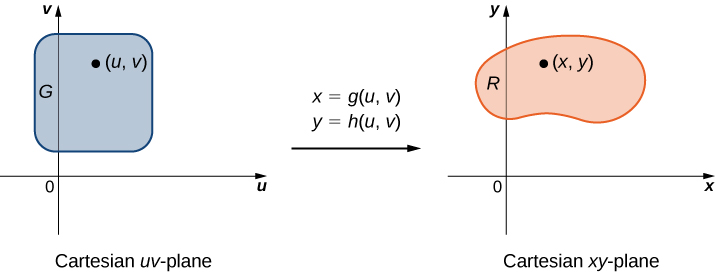
Recall from Substitution Rule the method of integration by substitution. When evaluating an integral such as
we substitute
Then
or
and the limits change to
and
Thus the integral becomes
and this integral is much simpler to evaluate. In other words, when solving integration problems, we make appropriate substitutions to obtain an integral that becomes much simpler than the original integral.
We also used this idea when we transformed double integrals in rectangular coordinates to polar coordinates and transformed triple integrals in rectangular coordinates to cylindrical or spherical coordinates to make the computations simpler. More generally,
Where
and
and
satisfy
and
A similar result occurs in double integrals when we substitute
and
Then we get
where the domain
is replaced by the domain
in polar coordinates. Generally, the function that we use to change the variables to make the integration simpler is called a transformation or mapping.
A planar transformation
is a function that transforms a region
in one plane into a region
in another plane by a change of variables. Both
and
are subsets of
For example, [link] shows a region
in the
transformed into a region
in the
by the change of variables
and
or sometimes we write
and
We shall typically assume that each of these functions has continuous first partial derivatives, which means
and
exist and are also continuous. The need for this requirement will become clear soon.

A transformation
defined as
is said to be a one-to-one transformation if no two points map to the same image point.
To show that
is a one-to-one transformation, we assume
and show that as a consequence we obtain
If the transformation
is one-to-one in the domain
then the inverse
exists with the domain
such that
and
are identity functions.
[link] shows the mapping
where
and
are related to
and
by the equations
and
The region
is the domain of
and the region
is the range of
also known as the image of
under the transformation
Suppose a transformation
is defined as
where
Find the image of the polar rectangle
in the
to a region
in the
Show that
is a one-to-one transformation in
and find
Since
varies from 0 to 1 in the
we have a circular disc of radius 0 to 1 in the
Because
varies from 0 to
in the
we end up getting a quarter circle of radius
in the first quadrant of the
([link]). Hence
is a quarter circle bounded by
in the first quadrant.
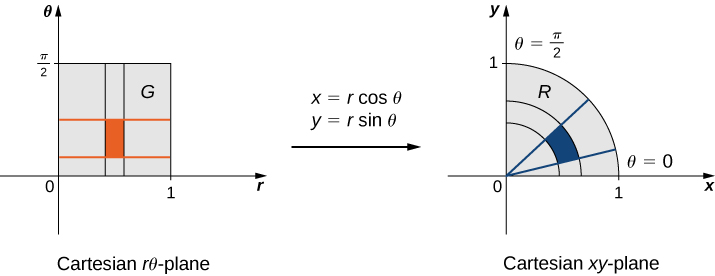
In order to show that
is a one-to-one transformation, assume
and show as a consequence that
In this case, we have
Dividing, we obtain
since the tangent function is one-one function in the interval
Also, since
we have
Therefore,
and
is a one-to-one transformation from
into
To find
solve for
in terms of
We already know that
and
Thus
is defined as
and
Let the transformation
be defined by
where
and
Find the image of the triangle in the
with vertices
and
The triangle and its image are shown in [link]. To understand how the sides of the triangle transform, call the side that joins
and
side
the side that joins
and
side
and the side that joins
and
side
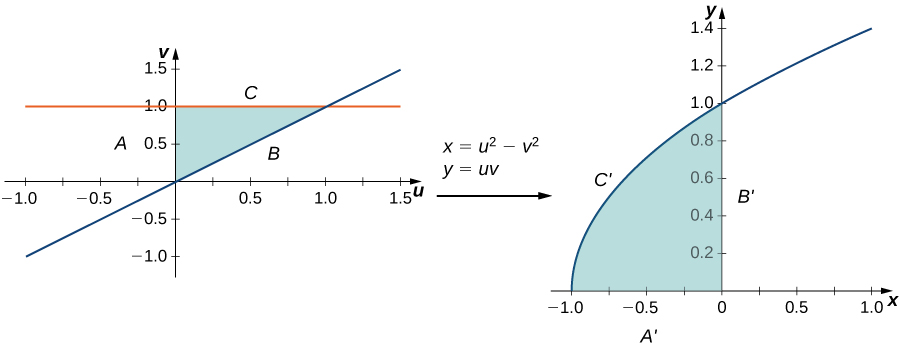
For the side
transforms to
so this is the side
that joins
and
For the side
transforms to
so this is the side
that joins
and
For the side
transforms to
(hence
so this is the side
that makes the upper half of the parabolic arc joining
and
All the points in the entire region of the triangle in the
are mapped inside the parabolic region in the
Let a transformation
be defined as
where
Find the image of the rectangle
from the
after the transformation into a region
in the
Show that
is a one-to-one transformation and find
where
and
Follow the steps of [link].
Recall that we mentioned near the beginning of this section that each of the component functions must have continuous first partial derivatives, which means that
and
exist and are also continuous. A transformation that has this property is called a
transformation (here
denotes continuous). Let
where
and
be a one-to-one
transformation. We want to see how it transforms a small rectangular region
units by
units, in the
(see the following figure).

Since
and
we have the position vector
of the image of the point
Suppose that
is the coordinate of the point at the lower left corner that mapped to
The line
maps to the image curve with vector function
and the tangent vector at
to the image curve is
Similarly, the line
maps to the image curve with vector function
and the tangent vector at
to the image curve is
Now, note that
Similarly,
This allows us to estimate the area
of the image
by finding the area of the parallelogram formed by the sides
and
By using the cross product of these two vectors by adding the kth component as
the area
of the image
(refer to The Cross Product) is approximately
In determinant form, the cross product is
Since
we have
The Jacobian of the
transformation
is denoted by
and is defined by the
determinant
Using the definition, we have
Note that the Jacobian is frequently denoted simply by
Note also that
Hence the notation
suggests that we can write the Jacobian determinant with partials of
in the first row and partials of
in the second row.
Find the Jacobian of the transformation given in [link].
The transformation in the example is
where
and
Thus the Jacobian is
Find the Jacobian of the transformation given in [link].
The transformation in the example is
where
and
Thus the Jacobian is
Find the Jacobian of the transformation given in the previous checkpoint:
Follow the steps in the previous two examples.
We have already seen that, under the change of variables
where
and
a small region
in the
is related to the area formed by the product
in the
by the approximation
Now let’s go back to the definition of double integral for a minute:
Referring to [link], observe that we divided the region
in the
into small subrectangles
and we let the subrectangles
in the
be the images of
under the transformation
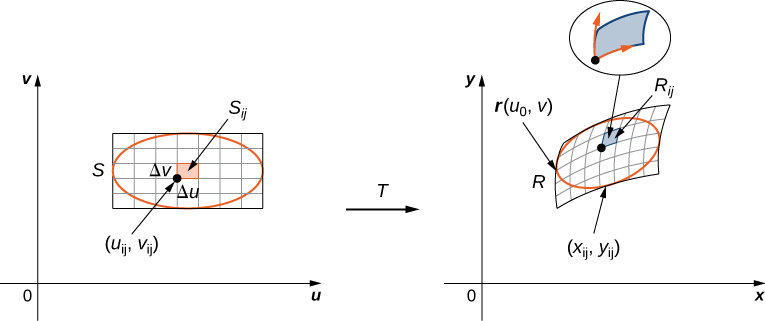
Then the double integral becomes
Notice this is exactly the double Riemann sum for the integral
Let
where
and
be a one-to-one
transformation, with a nonzero Jacobian on the interior of the region
in the
it maps
into the region
in the
If
is continuous on
then
With this theorem for double integrals, we can change the variables from
to
in a double integral simply by replacing
when we use the substitutions
and
and then change the limits of integration accordingly. This change of variables often makes any computations much simpler.
Consider the integral
Use the change of variables
and
and find the resulting integral.
First we need to find the region of integration. This region is bounded below by
and above by
(see the following figure).
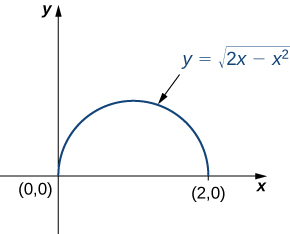
Squaring and collecting terms, we find that the region is the upper half of the circle
that is,
In polar coordinates, the circle is
so the region of integration in polar coordinates is bounded by
and
The Jacobian is
as shown in [link]. Since
we have
The integrand
changes to
in polar coordinates, so the double iterated integral is
Considering the integral
use the change of variables
and
and find the resulting integral.
Follow the steps in the previous example.
Notice in the next example that the region over which we are to integrate may suggest a suitable transformation for the integration. This is a common and important situation.
Consider the integral
where
is the parallelogram joining the points
and
([link]). Make appropriate changes of variables, and write the resulting integral.
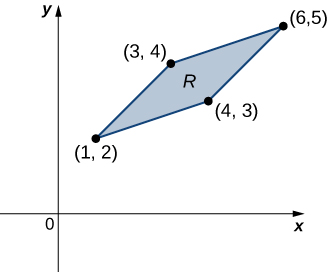
First, we need to understand the region over which we are to integrate. The sides of the parallelogram are
([link]). Another way to look at them is
and
Clearly the parallelogram is bounded by the lines
and
Notice that if we were to make
and
then the limits on the integral would be
and
To solve for
and
we multiply the first equation by
and subtract the second equation,
Then we have
Moreover, if we simply subtract the second equation from the first, we get
and
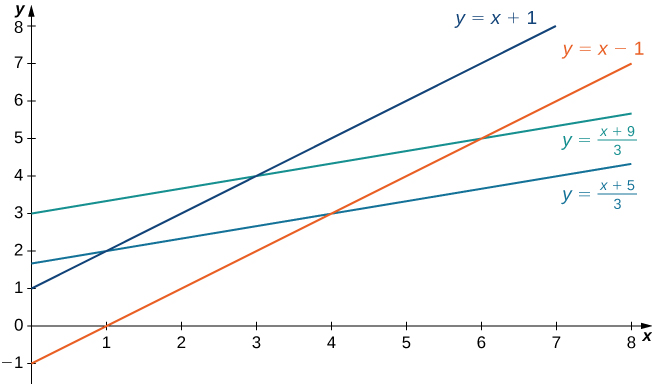
Thus, we can choose the transformation
and compute the Jacobian
We have
Therefore,
Also, the original integrand becomes
Therefore, by the use of the transformation
the integral changes to
which is much simpler to compute.
Make appropriate changes of variables in the integral
where
is the trapezoid bounded by the lines
Write the resulting integral.
and
and
Follow the steps in the previous example.
We are ready to give a problem-solving strategy for change of variables.
and then write the equations of the curves that form the boundary.
and
or
whichever occurs, by
In the next example, we find a substitution that makes the integrand much simpler to compute.
Using the change of variables
and
evaluate the integral
where
is the region bounded by the lines
and
and the curves
and
(see the first region in [link]).
As before, first find the region
and picture the transformation so it becomes easier to obtain the limits of integration after the transformations are made ([link]).

Given
and
we have
and
and hence the transformation to use is
The lines
and
become
and
respectively. The curves
and
become
and
respectively.
Thus we can describe the region
(see the second region [link]) as
The Jacobian for this transformation is
Therefore, by using the transformation
the integral changes to
Doing the evaluation, we have
Using the substitutions
and
evaluate the integral
where
is the region bounded by the lines
Sketch a picture and find the limits of integration.
Changing variables in triple integrals works in exactly the same way. Cylindrical and spherical coordinate substitutions are special cases of this method, which we demonstrate here.
Suppose that
is a region in
and is mapped to
in
([link]) by a one-to-one
transformation
where
and
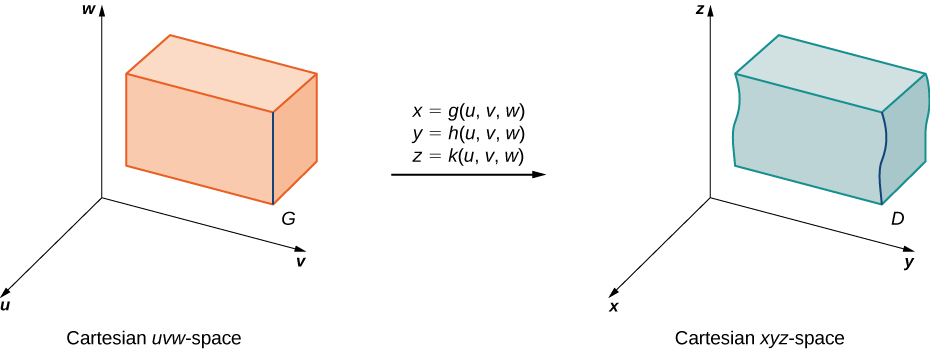
Then any function
defined on
can be thought of as another function
that is defined on
Now we need to define the Jacobian for three variables.
The Jacobian determinant
in three variables is defined as follows:
This is also the same as
The Jacobian can also be simply denoted as
With the transformations and the Jacobian for three variables, we are ready to establish the theorem that describes change of variables for triple integrals.
Let
where
and
be a one-to-one
transformation, with a nonzero Jacobian, that maps the region
in the
into the region
in the
As in the two-dimensional case, if
is continuous on
then
Let us now see how changes in triple integrals for cylindrical and spherical coordinates are affected by this theorem. We expect to obtain the same formulas as in Triple Integrals in Cylindrical and Spherical Coordinates.
Derive the formula in triple integrals for
from the Cartesian
to the Cartesian
([link]). Here
and
The Jacobian for the transformation is
We know that
so
Then the triple integral is
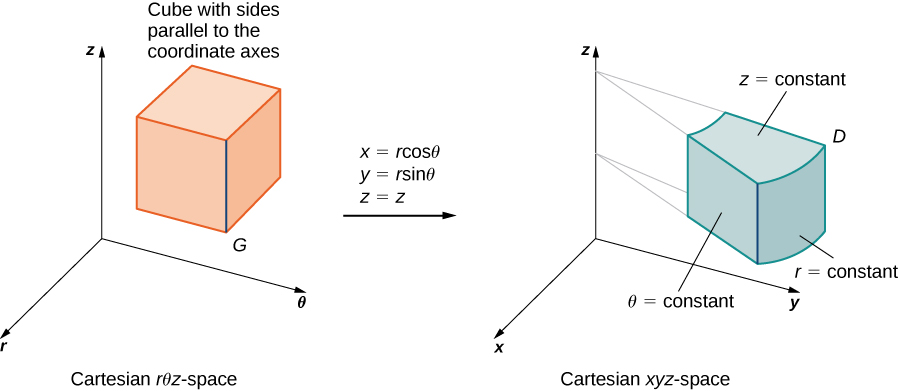
from the Cartesian
to the Cartesian
([link]). Here
and
The Jacobian for the transformation is
Expanding the determinant with respect to the third row:
Since
we must have
Thus
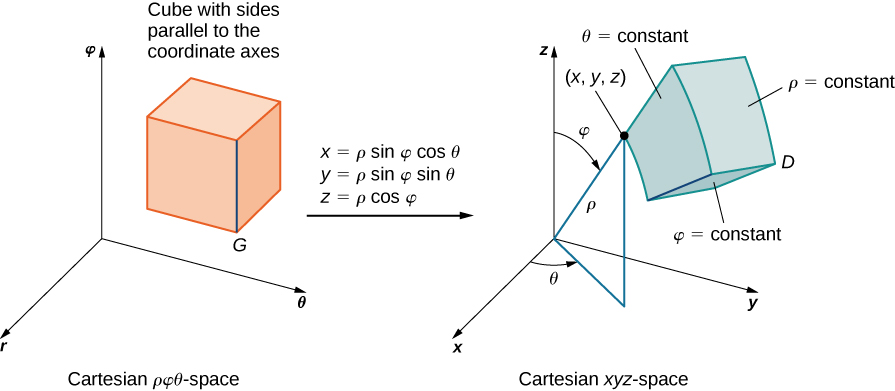
Then the triple integral becomes
Let’s try another example with a different substitution.
Evaluate the triple integral
in
by using the transformation
Then integrate over an appropriate region in
As before, some kind of sketch of the region
in
over which we have to perform the integration can help identify the region
in
([link]). Clearly
in
is bounded by the planes
We also know that we have to use
for the transformations. We need to solve for
Here we find that
and
Using elementary algebra, we can find the corresponding surfaces for the region
and the limits of integration in
It is convenient to list these equations in a table.
| Equations in |
for the region
| Corresponding equations in |
for the region
| Limits for the integration in |
| {: valign=”top”} | ———- |
| {: valign=”top”} |
| {: valign=”top”} |
| {: valign=”top”} |
| {: valign=”top”} |
| {: valign=”top”} |
| {: valign=”top”}{: .unnumbered summary=”This table consists of three columns and seven rows. The first row is a header row and reads Equations in x y z for the region D, Corresponding equations in u v w for the region G, and Limits for the integration in u v w. The first column down reads x = y/2, x = (y/2) + 1, y =, y = 4, z = 0, and z = 3. The second column down reads u + v = 2v/2 = v, u + v = (2v/2) + 1 = v + 1, 2v = 0, 2v = 4, 3w = 0, and 3w = 3. The last column reads u = 0, u =1, v = 0, v = 2, w = 0, and w = 1.” data-label=””}
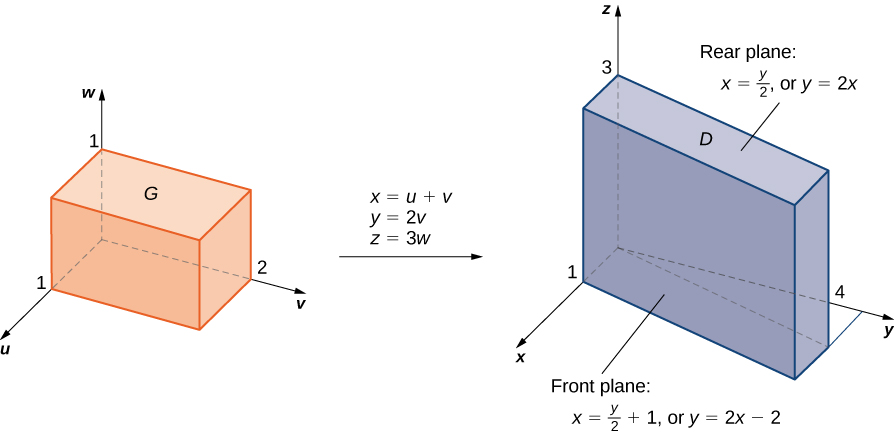
Now we can calculate the Jacobian for the transformation:
The function to be integrated becomes
We are now ready to put everything together and complete the problem.
Let
be the region in
defined by
Evaluate
by using the transformation
and
Make a table for each surface of the regions and decide on the limits, as shown in the example.
is a function that transforms a region
in one plane (space) into a region
in another plane (space) by a change of variables.
defined as
is said to be a one-to-one transformation if no two points map to the same image point.
is continuous on
then
is continuous on
then
In the following exercises, the function
on the region
bounded by the unit square is given, where
is the image of
under
is a
transformation.
through the function
of the unit square
and graph it.
a.
and
The functions
and
are continuous and differentiable, and the partial derivatives
are continuous on
b.
and
c.
is the rectangle of vertices
in the
the following figure.* * *
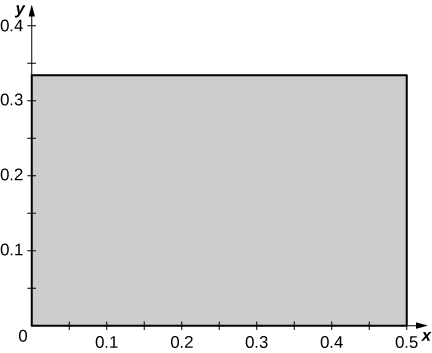
a.
and
The functions
and
are continuous and differentiable, and the partial derivatives
and
are continuous on
b.
and
c.
is the parallelogram of vertices
in the
see the following figure.* * *
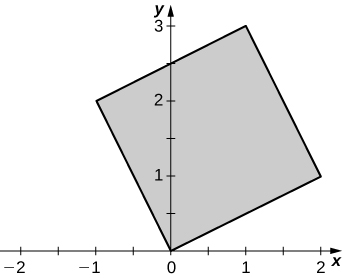
a.
and
The functions
and
are continuous and differentiable, and the partial derivatives
and
are continuous on
b.
and
c.
is the unit square in the
see the figure in the answer to the previous exercise.
In the following exercises, determine whether the transformations
are one-to-one or not.
is the rectangle of vertices
is the triangle of vertices
is not one-to-one: two points of
have the same image. Indeed,
is the square of vertices
where
is the triangle of vertices
is one-to-one: We argue by contradiction.
implies
and
Thus,
and
where
where
is not one-to-one:
In the following exercises, the transformations
are one-to-one. Find their related inverse transformations
where
where
where
and
where
and
where
where
In the following exercises, the transformation
and the region
are given. Find the region
where
where
where
where
In the following exercises, find the Jacobian
of the transformation.
The triangular region
with the vertices
is shown in the following figure.
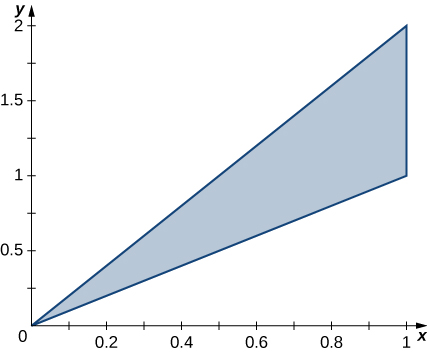
where
and
are real numbers with
such that
and
to find the area
of the region
The triangular region
with the vertices
is shown in the following figure.
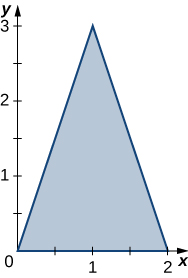
where
and
are real numbers with
such that
and
to find the area
of the region
a.
b. The area of
is* * *
In the following exercises, use the transformation
to evaluate the integrals on the parallelogram
of vertices
shown in the following figure.* * *
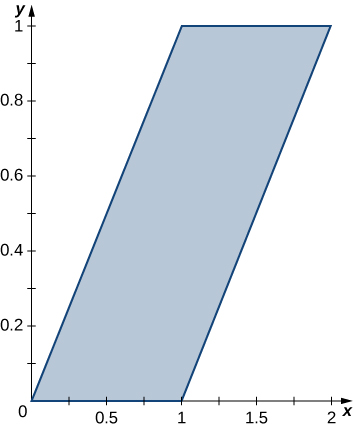
In the following exercises, use the transformation
to evaluate the integrals on the square
determined by the lines
and
shown in the following figure.* * *
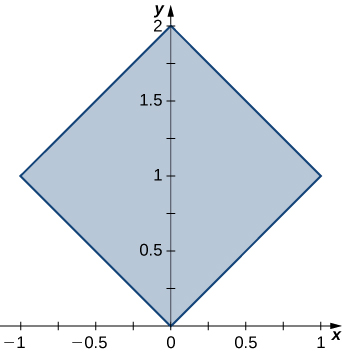
In the following exercises, use the transformation
to evaluate the integrals on the region
bounded by the ellipse
shown in the following figure.* * *
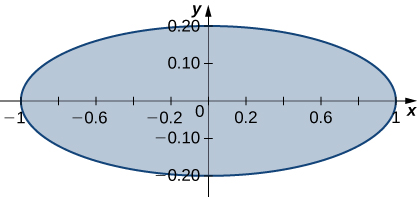
In the following exercises, use the transformation
to evaluate the integrals on the trapezoidal region
determined by the points
shown in the following figure.* * *
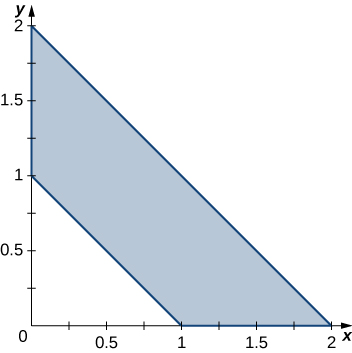
The circular annulus sector
bounded by the circles
and
the line
and the
is shown in the following figure. Find a transformation
from a rectangular region
in the
to the region
in the
Graph
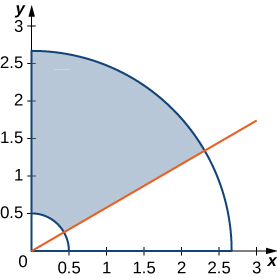
The solid
bounded by the circular cylinder
and the planes
is shown in the following figure. Find a transformation
from a cylindrical box
in
to the solid
in
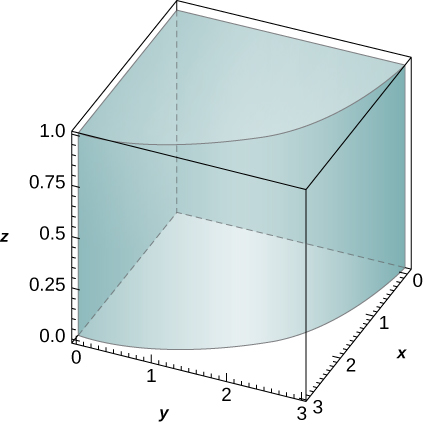
in the
Show that
where
is a continuous function on
and
is the region bounded by the ellipse
Show that
where
is a continuous function on
and
is the region bounded by the ellipsoid
[T] Find the area of the region bounded by the curves
and
by using the transformation
and
Use a computer algebra system (CAS) to graph the boundary curves of the region
[T] Find the area of the region bounded by the curves
and
by using the transformation
and
Use a CAS to graph the boundary curves of the region
The area of
is
the boundary curves of
are graphed in the following figure.* * *
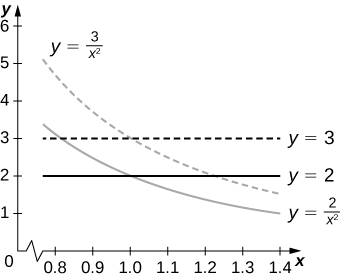
Evaluate the triple integral
by using the transformation
Evaluate the triple integral
by using the transformation
A transformation
of the form
where
are real numbers, is called linear. Show that a linear transformation for which
maps parallelograms to parallelograms.
The transformation
where
is called a rotation of angle
Show that the inverse transformation of
satisfies
where
is the rotation of angle
[T] Find the region
in the
whose image through a rotation of angle
is the region
enclosed by the ellipse
Use a CAS to answer the following questions.
Round your answer to two decimal places.
[T] The transformations
defined by
and
are called reflections about the
origin, and the line
respectively.
in the
through the transformation
by using a CAS. Round your answer to two decimal places.
a.
b.
is graphed in the following figure;* * *
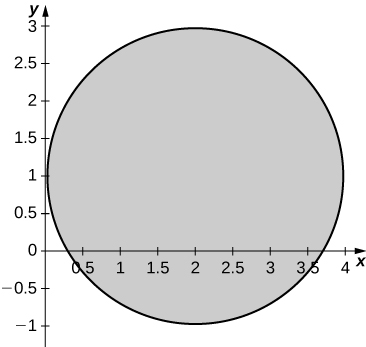
c.
[T] The transformation
of the form
where
is a positive real number, is called a stretch if
and a compression if
in the
Use a CAS to evaluate the integral
on the solid
by considering the compression
defined by
and
Round your answer to four decimal places.
[T] The transformation
where
is a real number, is called a shear in the
The transformation,
where
is a real number, is called a shear in the
of the trapezoidal region
bounded by
and
through the transformation
in the
by using the area of region
a.
b. The image
is the quadrilateral of vertices
c.
is graphed in the following figure;* * *
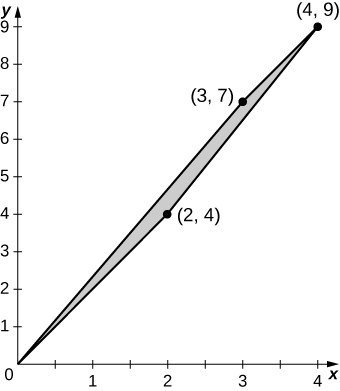
d.
Use the transformation,
and spherical coordinates to show that the volume of a region bounded by the spheroid
is
Find the volume of a football whose shape is a spheroid
whose length from tip to tip is
inches and circumference at the center is
inches. Round your answer to two decimal places.
[T] Lamé ovals (or superellipses) are plane curves of equations
where a, b, and n are positive real numbers.
bounded by Lamé ovals for
and
respectively.
bounded by the Lamé oval
also called a squircle and graphed in the following figure, into the unit disk.
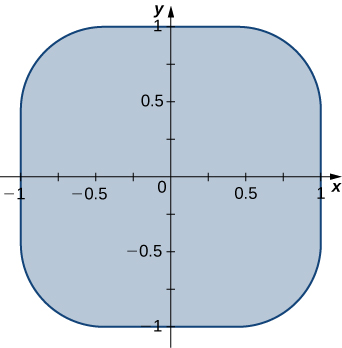
of the region
bounded by
Round your answer to two decimal places.
[T] Lamé ovals have been consistently used by designers and architects. For instance, Gerald Robinson, a Canadian architect, has designed a parking garage in a shopping center in Peterborough, Ontario, in the shape of a superellipse of the equation
with
and
Use a CAS to find an approximation of the area of the parking garage in the case
yards,
yards, and
yards.
True or False? Justify your answer with a proof or a counterexample.
Fubini’s theorem can be extended to three dimensions, as long as
is continuous in all variables.
True.
The integral
represents the volume of a right cone.
The Jacobian of the transformation for
is given by
False.
Evaluate the following integrals.
0
where
is a disk of radius
centered at the origin
where
1.475
For the following problems, find the specified area or volume.
The area of region enclosed by one petal of
The volume of the solid that lies between the paraboloid
and the plane
The volume of the solid bounded by the cylinder
and from
to
93.291
The volume of the intersection between two spheres of radius 1, the top whose center is
and the bottom, which is centered at
For the following problems, find the center of mass of the region.
on the circle with radius
in the first quadrant only.
in the region bounded by
and
on the inverted cone with radius
and height
The volume an ice cream cone that is given by the solid above
and below
The following problems examine Mount Holly in the state of Michigan. Mount Holly is a landfill that was converted into a ski resort. The shape of Mount Holly can be approximated by a right circular cone of height
ft and radius
ft.
If the compacted trash used to build Mount Holly on average has a density
find the amount of work required to build the mountain.
ft-lb
In reality, it is very likely that the trash at the bottom of Mount Holly has become more compacted with all the weight of the above trash. Consider a density function with respect to height: the density at the top of the mountain is still density
and the density increases. Every
feet deeper, the density doubles. What is the total weight of Mount Holly?
The following problems consider the temperature and density of Earth’s layers.
[T] The temperature of Earth’s layers is exhibited in the table below. Use your calculator to fit a polynomial of degree
to the temperature along the radius of the Earth. Then find the average temperature of Earth. (Hint: begin at
in the inner core and increase outward toward the surface)
| Layer | Depth from center (km) | Temperature |
|---|---|---|
| Rocky Crust | 0 to 40 | 0 |
| Upper Mantle | 40 to 150 | 870 |
| Mantle | 400 to 650 | 870 |
| Inner Mantel | 650 to 2700 | 870 |
| Molten Outer Core | 2890 to 5150 | 4300 |
| Inner Core | 5150 to 6378 | 7200 |
average temperature approximately
[T] The density of Earth’s layers is displayed in the table below. Using your calculator or a computer program, find the best-fit quadratic equation to the density. Using this equation, find the total mass of Earth.
| Layer | Depth from center (km) | Density (g/cm3) |
|---|---|---|
| Inner Core | ||
| Outer Core | ||
| Mantle | ||
| Upper Mantle | ||
| Crust |
The following problems concern the Theorem of Pappus (see Moments and Centers of Mass for a refresher), a method for calculating volume using centroids. Assuming a region
when you revolve around the
the volume is given by
and when you revolve around the
the volume is given by
where
is the area of
Consider the region bounded by
and above
Find the volume when you revolve the region around the
Find the volume when you revolve the region around the
in two variables is a
determinant:
the Jacobian
in three variables is a
determinant:
defined as
is said to be one-to-one if no two points map to the same image point
that transforms a region
in one plane into a region
in another plane by a change of variables
in one plane into a region
in another plane by a change of variables

You can also download for free at http://cnx.org/contents/9a1df55a-b167-4736-b5ad-15d996704270@5.1
Attribution: